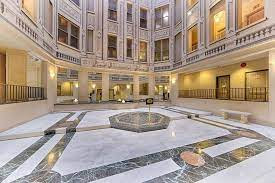Weekend, May 1-2, 2021 -When the more decoration on your building was high style


Roosevelt Island: A Vibrant Sustainable Community
JANE’S WALK LED BY THEODORE LIEBMAN, ARCHITECT, PERKINS EASTMAN, AND JUDITH BERDY, PRESIDENT, ROOSEVELT ISLAND HISTORICAL SOCIETY
MONDAY, MAY 3, 1:00 P.M. ON ZOOM
We will review the history of the island and its change from the infamous Welfare Island to today’s vibrant Roosevelt Island community and the 1969 Johnson Plan and its execution. We will review all the architecture, the restoration of landmarks, and sustainability features on the island, the tram and subway, the new Cornell Tech University and Four Freedoms Park created as a memorial to Franklin Delano Roosevelt and designed by Louis I. Kahn.
TO REGISTER:
When watching the news about an FBI raid, I recognized the building at Madison Avenue and 66th Street. I decided to stop wondering and check it out along with the architects who designed this apartment house and two others
45 EAST 66 STREET

45 East 66th Street / 773 Madison Avenue
Describing this trio of buildings as “the best gingerbread in town,” Paul Golberger noted in his book, “The City Observed, A Guide To the Architecture of New York, An Illustrated History” (Vintage Books, 1979), that this was “the best” of the trio, adding that “The detail is an eclectic mix of Elizabethan and Flemish Gothic, and it is just elaborate enough to be showy, but restrained enough not to compete with the separate, secondary level of texture created by the dozens of 12-over-12 double-hung windows, a veritable curtain of tiny square panes.”
Some history of the site by Christopher Gray (1988):
“In 1905, Charles F. Rogers, who had built the Prince George and other hotels, bought the All Souls church site at the northeast corner of Madison Avenue and 66th Street. Rogers, the son of the sculptor John S. Rogers, lived at 60th Street and Madison Avenue and was an All Souls parishioner….The new building dominated the Madison Avenue brownstones, and its distinctive round corner tower was unusually prominent. The square-doughnut structure has a central light court, but the majestic multipaned windows -framed in white terra-cotta and rising to overhanging, screen-like assemblies of Gothic ornament – are what catch the eye….The building was divided into only two apartments…on each floor. Only a handful survived intact, still grand and elegant but with most of their unusual woodwork painted over. The building opened in 1908 as 777 Madison Avenue…..In 1929 the entrance was moved onto East 66th Street, giving the building its present address,…The exterior remained in fairly good shape except for a gradual buildup of grime from engine exhaust (Madison Avenue streetcars were replaced by buses in the 1930’s). From 1928 to 1973, the building was owned by the Bing & Bing real estate company. Major change came after the mid-50’s, with most of the overhanging decorative work at the sixth and 10th floors either cut back or stripped away entirely. In 1973, 45 East 66th Street was acquired by a builder, Sigmund Sommer, who cut back some services, discharged the elevator attendant and replaced incandescent lighting with fluorescent in the hallways. Tenants conducted a rent strike….They ultimately won most of their battles and the Bing interests took the building back in the spring of 1977, just as a tenant effort of landmark designation was starting….In 1987, a partnership managed by M. J. Raynes bought the building and began a cooperative conversion plan that was completed last month.”
ALWYN COURT

ALWYN COURT 180 WEST 58 STREET
The Alwyn Court, also known as The Alwyn, is an apartment building at 180 West 58th Street in Midtown Manhattan, New York City.
The building is at the southeast corner with Seventh Avenue, one block south of Central Park. The Alwyn Court was built between 1907 and 1909 and was designed by Harde & Short in the French Renaissance style. It is one of several luxury developments constructed along Seventh Avenue during the late 19th and early 20th century.
The building is thirteen stories tall. Its facade is clad with elaborate terracotta ornamentation in the Francis I style, with a main entrance on Seventh Avenue and 58th Street. Inside is an octagonal courtyard with a painted facade by artist Richard Haas, as well as a location of the Petrossian caviar bar. The Alwyn Court was originally built with twenty-two elaborately decorated apartments, two on every floor, which typically had fourteen rooms and five bathrooms. The interior was subdivided into 75 apartments in 1938.
The Alwyn Court was named after Alwyn Ball Jr., one of the building’s developers. Despite a fire shortly after opening, the Alwyn Court quickly became one of New York City’s most expensive apartment buildings. During the early 20th century, ownership changed several times. By the 1930s, the last luxury tenant had moved out, and the building’s interior was completely rebuilt. The Alwyn Court was made a New York City designated landmark in 1966, and added to the National Register of Historic Places in 1979. The building was renovated and converted to cooperative apartments in 1980, and the facade was restored in the late 1990s and early 2000s.
RED HOUSE
From A DAYTONIAN IN MANHATTAN

Harde & Short’s 1904 “Red House” — No. 350 West 85th Street

Architects Herbert Spencer Harde and Richard Thomas Short kept themselves busy around the turn of the century designing tenement houses throughout the city. Harde branched out into real estate at some point, establishing the Eronel Realty Company – “Eronel” being his wife Lenore’s name spelled backwards. With the Upper West Side rapidly developing, Eronel Realty acquired the plot of land at 350 West 85th Street and, in 1903, commissioned Harde & Short to design an apartment building on the lot – in short, Harde hired himself. Terra cotta was just making its mark as a remarkably versatile and relatively inexpensive material and the architects embraced it with gusto for this project. In an effort to lure well-to-do residents from private homes into apartments, Harde & Short lavished the façade with intricate terra cotta ornamentation. It would be a stark departure from the firm’s usual tenement buildings. Drawing on several styles and periods, they created an eye-catching and unique structure. Expanses of multi-paned windows hardened back to great English country estates while dripping Gothic screens coexisted with terra cotta salamanders – the symbol of Francis I.

Harde & Short played the red brick and white terra cotta against one another, creating visual interest that was accentuated by the light and shadow of the façade’s angles and bays. The distinctive six-story building was completed in 1904, drawing the unexcited comment from The Real Estate Record & Guide which said it was “a departure from the usual.”
The salamander, symbol of Francis I, would appear again in the facade of Harde & Short’s magnificent Alwyn Court — photo by Alice Lum
Harde named his building “Red House” and immediately moved in with Lenore. Joining them in the new building were socially-important Mr. and Mrs. William Smith Young and their two daughters, Caroline Grace and Lucy. The 32-year old attorney was a member of no fewer than five exclusive clubs, including the Columbia Yacht Club and the Cornell Club.

Mrs. Young, who went by the ponderous name Caroline Marshall Page Young was a Daughter of the American Revolution and was active in philanthropic and charitable causes. On May 14, 1907, for instance, she and Mrs. Franklin P. Duryea, who lived in the elaborate Ansonia Apartments, hosted “a bridge” to aid the School for Crippled Children. Reflective of the difference between West Side and East Side, many of the tenants here were movers and shakers; unafraid to break the chains of tradition or to question the status-quo.

At this same time the banker Ashton Parker was living here. His astonishingly modern views on smoking in public sound more like 2011 than 1905. Parker complained to the editor of The New York Times, calling public smoking “a nuisance” and “disagreeable to ladies.” “Why is it that smoking is forbidden in the ladies’ cabin, yet is permitted in the Wall Street ferry house, where the ladies wait for the boats?” he asked. Other early tenants were Harvard graduate Semour M. Peyser and William Robinson. The modern-thinking Robinson owned an early motorcycle which, sadly in 1906, caused him to be charged with “overspeeding on a motor bicycle.” He was released on $100 bail. Smith College alumna Nancy Elizabeth Barnhart was living here in 1915 when the women’s rights advocate won honorable mention for her submission of a poster design for the Woman Suffrage Campaign Poster Competition exhibited at the gallery of the Society of Beaux Arts Architects. Not all of the endeavors of the residents were so lofty, unfortunately. Alexander S. Timson was a 20-year old insurance broker when he lived here in 1911. On his wedding day, June 10, Detectives arrived at Red House where they arrested Timson as a jewel thief. When he was searched at the station house, police found two diamond rings set with sapphires, two diamond hatpins also set with sapphires, one diamond ring set with pearls and another diamond ring. “This is terrible. I am to be married tonight,” Timson protested. “My people, who live in this city, are wealthy, and will help me out of this trouble.” Timson’s people never showed up.
Little has changed on the exterior of Red House. The windows have been replaced, as have the entrance doors and the original paint scheme for the windows has been changed to black. Yet it appears very much as it did when Lenore and Herbert Harde moved in in 1904 – what the AIA Guide to New York City calls “a romantic six-story masterpiece.”
WEEKEND PHOTO OF THE DAY
SEND YOUR SUBMISSION TO:
ROOSEVELTISLANDHISTORY@GMAIL.COM

FRIDAY PHOTO OF THE DAY
IN HONOR OF GLASS ART, THE PHOTO IS FROM STEUBEN
GLASS, THE GAZELLE BOWL. SEE MONDAY’S EDITION
LAURA HUSSEY& ED LITCHER GOT IT!!!

Text by Judith Berdy
Thanks to Bobbie Slonevsky for her dedication to Blackwell’s Almanac and the RIHS
Thanks to Deborah Dorff for maintaining our website
Edited by Melanie Colter and Deborah Dorff
All image are copyrighted (c) Roosevelt Island Historical Society unless otherwise indicated
WIKIPEDIA
FRIENDS OF UPPER EAST SIDE
A DAYTONIAN IN MANHATTAN
NY TIMES/CHRISTOPHER GRAY
FUNDING PROVIDED BY ROOSEVELT ISLAND OPERATING CORPORATION PUBLIC PURPOSE GRANTS CITY COUNCIL REPRESENTATIVE BEN KALLOS DISCRETIONARY FUNDING THRU DYCD


Copyright © 2021 Roosevelt Island Historical Society, All rights reserved.Our mailing address is:
rooseveltislandhistory@gmail.com



Leave a comment